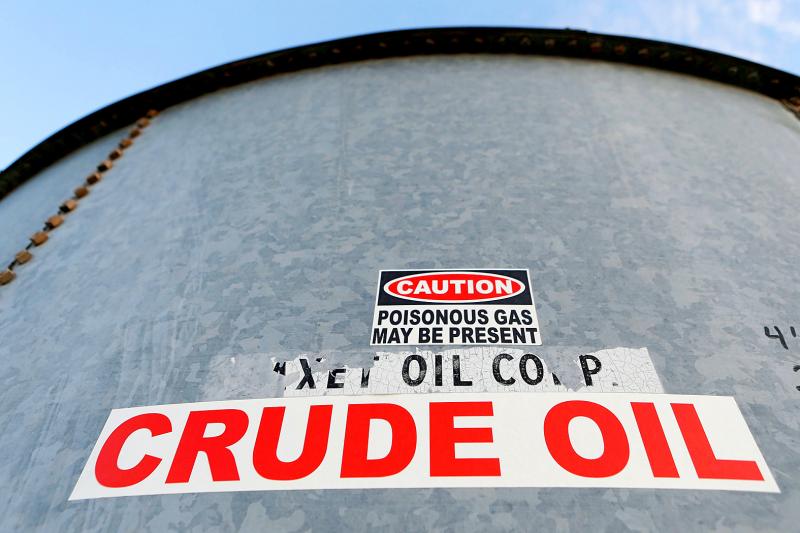Oil on Friday slid by the most in three weeks as a stronger US dollar and weak US economic data stoked concerns over an economic rebound.
The US dollar strengthened, reducing the appeal of commodities priced in the currency. US consumer sentiment cooled more than forecast this month and other economic data such as sluggish retail sales and producer prices also portray the obstacles still facing the country as it emerges from the COVID-19 pandemic.
Meanwhile, US president-elect Joe Biden said that he would ask the US Congress for US$1.9 trillion to fund immediate relief for the US economy, which has been pummeled by the pandemic, but the large price tag and inclusion of initiatives opposed by many Republicans set up the aid package for a drawn out legislative battle.

Photo: Reuters
“We’ve had a lot of strength in a number of different markets and now we’re getting a pullback,” said Bill O’Grady, executive vice president at Confluence Investment Management in St Louis, Missouri.
O’Grady said that oil markets need “driving to go up. If people have money and no place to spend it, it doesn’t make any difference.”
West Texas Intermediate for February delivery fell 2.86 percent to US$52.04 a barrel, down 0.38 percent for the week.
Brent crude for March delivery dropped 2.34 percent to US$55.10 a barrel, down 1.59 percent from a week earlier.
Despite the pullback in oil futures, vaccine breakthroughs and Saudi Arabia’s pledge earlier this month to deepen output cuts are expected to support prices.
JPMorgan Chase & Co said that a “nasty deficit” could emerge in the oil market later this year.
Meanwhile, technical indicators had been flashing warnings signs all week. The 14-day Relative Strength Index for both US and global benchmark crude futures traded above 70 this week in a sign that they were overbought, although both slipped under that level on Friday.
A “short-term pullback” is likely in store for “oil prices, given the recent loss of support from a number of key factors,” Rabobank commodities strategist Ryan Fitzmaurice wrote in a note. “With that said, the dips may be shallow as investor appetite for commodities appears to be increasing rapidly following the recent bullish oil calls and talk of a commodity super-cycle from some of the larger and more prominent US investment banks.”
The market’s structure has also softened. Brent’s prompt timespread dipped back into contango on Friday, a bearish structure where nearby prices are cheaper than later-dated ones.
This week has seen the annual commodity index rebalancing take place — a move that was expected to see as much as US$9 billion flow into the oil market.
Since it began on Friday last week, there has been a surge in so-called trading-at-settlement volumes, an instrument often used by participants with index exposure.
For Brent, average volumes over the past five days have reached a record.
Additional reporting by staff writer

Among the rows of vibrators, rubber torsos and leather harnesses at a Chinese sex toys exhibition in Shanghai this weekend, the beginnings of an artificial intelligence (AI)-driven shift in the industry quietly pulsed. China manufactures about 70 percent of the world’s sex toys, most of it the “hardware” on display at the fair — whether that be technicolor tentacled dildos or hyper-realistic personalized silicone dolls. Yet smart toys have been rising in popularity for some time. Many major European and US brands already offer tech-enhanced products that can enable long-distance love, monitor well-being and even bring people one step closer to

TRANSFORMATION: Taiwan is now home to the largest Google hardware research and development center outside of the US, thanks to the nation’s economic policies President Tsai Ing-wen (蔡英文) yesterday attended an event marking the opening of Google’s second hardware research and development (R&D) office in Taiwan, which was held at New Taipei City’s Banciao District (板橋). This signals Taiwan’s transformation into the world’s largest Google hardware research and development center outside of the US, validating the nation’s economic policy in the past eight years, she said. The “five plus two” innovative industries policy, “six core strategic industries” initiative and infrastructure projects have grown the national industry and established resilient supply chains that withstood the COVID-19 pandemic, Tsai said. Taiwan has improved investment conditions of the domestic economy

Malaysia’s leader yesterday announced plans to build a massive semiconductor design park, aiming to boost the Southeast Asian nation’s role in the global chip industry. A prominent player in the semiconductor industry for decades, Malaysia accounts for an estimated 13 percent of global back-end manufacturing, according to German tech giant Bosch. Now it wants to go beyond production and emerge as a chip design powerhouse too, Malaysian Prime Minister Anwar Ibrahim said. “I am pleased to announce the largest IC (integrated circuit) Design Park in Southeast Asia, that will house world-class anchor tenants and collaborate with global companies such as Arm [Holdings PLC],”

MAJOR BENEFICIARY: The company benefits from TSMC’s advanced packaging scarcity, given robust demand for Nvidia AI chips, analysts said ASE Technology Holding Co (ASE, 日月光投控), the world’s biggest chip packaging and testing service provider, yesterday said it is raising its equipment capital expenditure budget by 10 percent this year to expand leading-edge and advanced packing and testing capacity amid strong artificial intelligence (AI) and high-performance computing chip demand. This is on top of the 40 to 50 percent annual increase in its capital spending budget to more than the US$1.7 billion to announced in February. About half of the equipment capital expenditure would be spent on leading-edge and advanced packaging and testing technology, the company said. ASE is considered by analysts